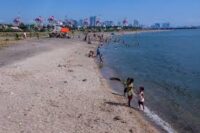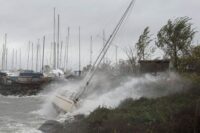INTRODUCTION
This article is a part II of my previous publication, “Wave Dynamics Retain Dolomite Sand Pebbles Intact at the Beachfront along Manila Bay,” in the Maritime Review’s Nov–Dec 2020 issue.
In addition to that previous article, this topic presents the real time wave system along Roxas Blvd., Manila Bay, explaining my analogy by illustration and definition, the physical behavior of the wave system prevailing in Manila Bay Area.
The aim of this reading material is to contribute a high level of confidence by presenting theory and facts on what is happening on the beachfront. You can expect the dolomite sand pebbles not to be eroded by underwater turbulence of the bottom of the seabed of Roxas Blvd for a long period of time, for generations to come, if not forever.
Analogy of Wave Systems. Presented in Fig. 1 is the wave system along Roxas Blvd; its cycles and probability of occurrence of 106 times per 1000 observations in the Philippine Sea Areas of Responsibilities (World Meteorological Observation Statistics).
| Legend | Descriptions |
| 1 | Direction of Wave Kinetic Energy slamming, colliding and pounding the seawall of Roxas Blvd., at precise intervals of 14.8 seconds, 4.86 times/minutes, 243.28 times per hour or 5,837.83 times/24 hours. |
| 2 | Wave energy absorbed by the seawall at the point of impact of the seawall from the wave, energy, dissipates which turns into back wash waves in equilibrium, at the seawall convergence zone.
|
| 3 | Wave spray/spilling water waves are thrown to the atmosphere upon impact on the seawall. |
| 4 | Underwater turbulence with the trochoidal wave at the surface is maximum while underwater turbulence is negligible due to the effect of the constant compressive force of the hydrostatic pressure. |
| 5 | The seawater hydrostatic pressure constantly exerts towards the seabed, and the magnitude of force is directly proportional to seawater density and depth per square unit that press the dolomite sand pebbles to the seabed. |
| 6 | A layer of Dolomite sand pebble has specific gravity of 2.85 ± 0.01 with granular interlocking particle sizes. |
| 7 | A layer of sand bedding with specific gravity of 1.70 with silt and smaller particles of sand passing sieve size #200 equivalent to silt. |
| 8 | Silt and smaller sand particles are washed away towards the seawall by underwater turbulence deposited on top of dolomite sand pebbles at the edge of the beachfront before the wave convergence zone. |
| 9 | Pressure of seawater is zero at the wave surface profile and maximum in deeper water. Water is incompressible. |
| 10 | Wave profile energy is maximum at the surface of the sea triggered by the wind in contact/friction with the sea surface and normally moves in the wind’s direction. |
SANDBARS AT MANILA YACHT BASIN AND BASECO BEACH
The sandbars at Baseco Beach and Manila Yacht remain intact. They are not being eroded by strong wind and tidal currents despite being exposed constantly to unseen forces of nature. The sandbars remain deposited on said area.
Sands deposited by tidal currents and waves along the beachfront of Baseco Waterfront and Manila Yacht Basin have remained intact and undisturbed by wave and current despite the fact that these beaches have no beach protection from underwater turbulence, current and backwash waves, and predominant forces of nature which is the kinetic energy of the waves constantly pushing the sandbars inland during high tide and rough sea conditions. Yet they have never eroded. In theory, the forces of nature create islands that initially start as shoals, sandbars, etc.
Shown in Fig. 4, is the wave convergence along the seawall of Roxas Blvd., Manila Bay Area. This observation is at real time in constant occurrence, during which the wave surface kinetic energy dissipates upon colliding and slamming the seawall, then backwash waves and spilling water wave spray are thrown up in the atmosphere. The backwash waves and spilling water that accumulate along the seawall or at the wave convergence zone create differences in seawater elevation and in turn said mass of seawater will just flow back seaward, called gravity waves, and will be carried during high and low tide. Said movement of water neither affects nor erodes resilient properties of the dolomite sand pebbles pushing at the opposite direction towards the foreshore or the deeper part of Manila Bay.

Figure 5. Wave Intervals Diagram Depicting the Slamming and Pounding the Seawall During High Tide and Rough Sea Condition
Figure 5 shows the concentrated kinetic energy of the waves with precise time interval slamming and pounding the seawall and dissipate to spilling wave and back wash, maintaining the equilibrium of sea surface at the wave convergence zone.
CONCLUSION
Nature protects the dolomite sand pebbles beachfront from underwater turbulence. The constant real time direction of waves rushing towards the seawall is in total harmony and favorable to the said beachfront project.
ABOUT THE RESEARCHER
- CAPT BAINO retired from the Philippine Navy in 2004. A registered Civil Engineer and Naval Architect in the Professional Regulation Commission (PRC) in the Philippines.
- His early years in the Philippine Navy was with the Philippine Navy Seabees Mobile Construction Battalion and Waterfront Dredge Unit involved in the early phases of the reclamation of Cultural Center and Folk Arts Theater area in the early years of 73 and gain some training experience with the US Navy Seabees Amphibious Construction Battalion in support to Marine Landing Operation during series of SEATO Naval Exercise and MAULEX (Marine Amphibious Unit Landing Exercise) in the Philippines.
- Sent by the NAVY to complete the Advance Engineer Officer Course in Military Engineering at the United States Army Engineer School, Fort Leonard Wood, Missouri in 1991 and completed a training course in Underwater Archeology in Asia Institute of Technology (AIT) in Bangkok, Thailand in 1980 under the sponsorship of DOST/SPAFA (Special Project in Fine Arts) in salvage, collection and preservation heritage marine wrecks.
- He participated in Cross-Training Exercises with the US Navy 7th Fleet Mobile Diving and Salvage Unit (MODSU) in Ship Salvage Exercise during the Cooperation Afloat Readiness Training (CARAT 2001-2003). CAPT BAINO was awarded Outstanding Achievement Medal as Ship Salvage Director of the Naval Sea System Command by PGMA during the 2002 Navy Day Celebration in Sangley Point Cavite City, for the successful refloating and salvage of PF-7 BRP Andres Bonifacio and 3 other sunken vessels at the Capt. Yutadco Pier, Naval Shipyard, Fort San Felipe, Cavite City.
- He worked for 2 years as Operations Manager with the International Operations and Maintenance Company (IOMC), Land Oil Group of Companies in Port and Harbor Facility Operation and Maintenance contract with the Saudi Ports Authority, Saudi Arabia from 1981 to 1983.
- Presently, he is Associate Editor for Technical Matters in the Maritime Review Magazine and the Maritime Forum in the Philippines.




